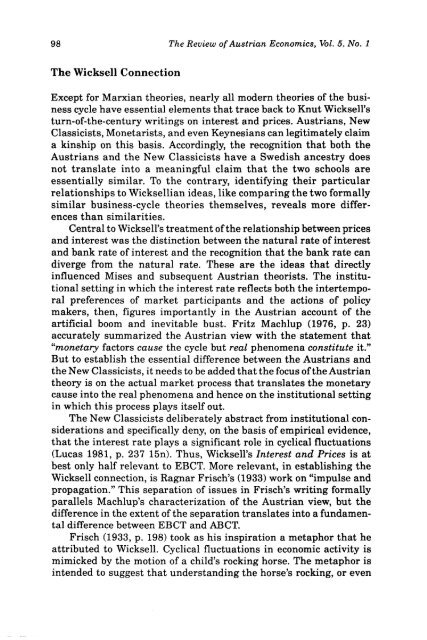Review of Austrian Economics - The Ludwig von Mises Institute
Review of Austrian Economics - The Ludwig von Mises Institute
Review of Austrian Economics - The Ludwig von Mises Institute
You also want an ePaper? Increase the reach of your titles
YUMPU automatically turns print PDFs into web optimized ePapers that Google loves.
98 <strong>The</strong> <strong>Review</strong> <strong>of</strong> <strong>Austrian</strong> <strong>Economics</strong>, Vol. 5, No. 1<br />
<strong>The</strong> Wicksell Connection<br />
Except for Marxian theories, nearly all modern theories <strong>of</strong> the business<br />
cycle have essential elements that trace back to Knut Wicksell's<br />
turn-<strong>of</strong>-the-century writings on interest and prices. <strong>Austrian</strong>s, New<br />
Classicists, Monetarists, and even Keynesians can legitimately claim<br />
a kinship on this basis. Accordingly, the recognition that both the<br />
<strong>Austrian</strong>s and the New Classicists have a Swedish ancestry does<br />
not translate into a meaningful claim that the two schools are<br />
essentially similar. To the contrary, identifying their particular<br />
relationships to Wicksellian ideas, like comparing the two formally<br />
similar business-cycle theories themselves, reveals more differences<br />
than similarities.<br />
Central to Wicksell's treatment <strong>of</strong> the relationship between prices<br />
and interest was the distinction between the natural rate <strong>of</strong> interest<br />
and bank rate <strong>of</strong> interest and the recognition that the bank rate can<br />
diverge from the natural rate. <strong>The</strong>se are the ideas that directly<br />
influenced <strong>Mises</strong> and subsequent <strong>Austrian</strong> theorists. <strong>The</strong> institutional<br />
setting in which the interest rate reflects both the intertemporal<br />
preferences <strong>of</strong> market participants and the actions <strong>of</strong> policy<br />
makers, then, figures importantly in the <strong>Austrian</strong> account <strong>of</strong> the<br />
artificial boom and inevitable bust. Fritz Machlup (1976, p. 23)<br />
accurately summarized the <strong>Austrian</strong> view with the statement that<br />
"monetary factors cause the cycle but real phenomena constitute it."<br />
But to establish the essential difference between the <strong>Austrian</strong>s and<br />
the New Classicists, it needs to be added that the focus <strong>of</strong> the <strong>Austrian</strong><br />
theory is on the actual market process that translates the monetary<br />
cause into the real phenomena and hence on the institutional setting<br />
in which this process plays itself out.<br />
<strong>The</strong> New Classicists deliberately abstract from institutional considerations<br />
and specifically deny, on the basis <strong>of</strong> empirical evidence,<br />
that the interest rate plays a significant role in cyclical fluctuations<br />
(Lucas 1981, p. 237 15n). Thus, Wicksell's Interest and Prices is at<br />
best only half relevant to EBCT. More relevant, in establishing the<br />
Wicksell connection, is Ragnar Frisch's (1933) work on "impulse and<br />
propagation." This separation <strong>of</strong> issues in Frisch's writing formally<br />
parallels Machlup's characterization <strong>of</strong> the <strong>Austrian</strong> view, but the<br />
difference in the extent <strong>of</strong> the separation translates into a fundamental<br />
difference between EBCT and ABCT.<br />
Frisch (1933, p. 198) took as his inspiration a metaphor that he<br />
attributed to Wicksell. Cyclical fluctuations in economic activity is<br />
mimicked by the motion <strong>of</strong> a child's rocking horse. <strong>The</strong> metaphor is<br />
intended to suggest that understanding the horse's rocking, or even

















